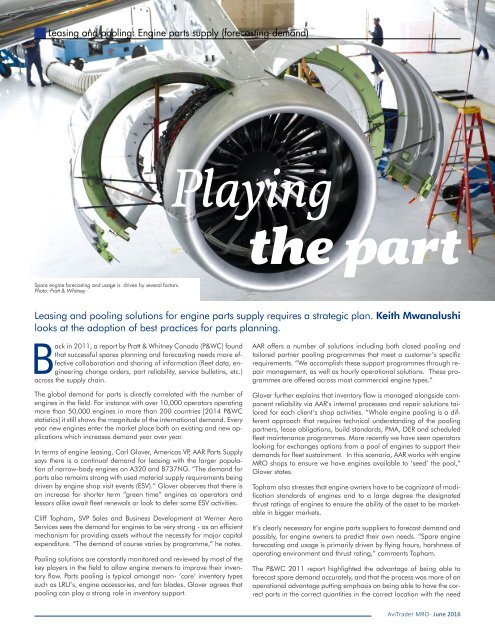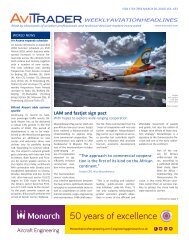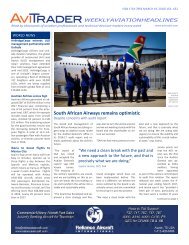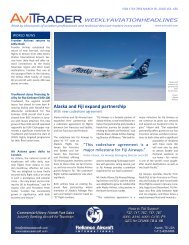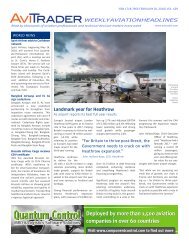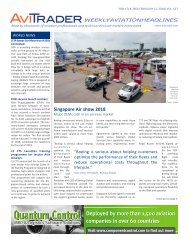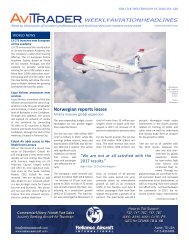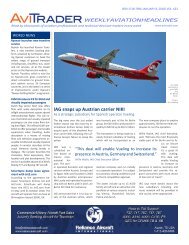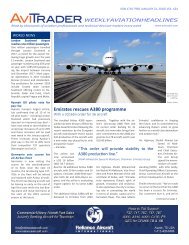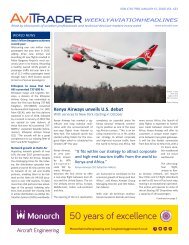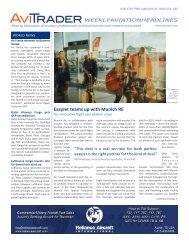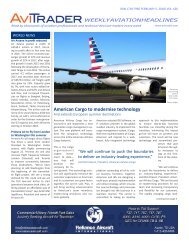AviTrader_Monthly_MRO_e-Magazine_2016-06
AviTrader_Monthly_MRO_e-Magazine_2016-06
AviTrader_Monthly_MRO_e-Magazine_2016-06
Create successful ePaper yourself
Turn your PDF publications into a flip-book with our unique Google optimized e-Paper software.
Leasing and pooling: Engine parts supply (forecasting demand)<br />
19<br />
Playing<br />
the part<br />
Spare engine forecasting and usage is driven by several factors.<br />
Photo: Pratt & Whitney<br />
Leasing and pooling solutions for engine parts supply requires a strategic plan. Keith Mwanalushi<br />
looks at the adoption of best practices for parts planning.<br />
Back in 2011, a report by Pratt & Whitney Canada (P&WC) found<br />
that successful spares planning and forecasting needs more effective<br />
collaboration and sharing of information (fleet data, engineering<br />
change orders, part reliability, service bulletins, etc.)<br />
across the supply chain.<br />
The global demand for parts is directly correlated with the number of<br />
engines in the field. For instance with over 10,000 operators operating<br />
more than 50,000 engines in more than 200 countries [2014 P&WC<br />
statistics] it still shows the magnitude of the international demand. Every<br />
year new engines enter the market place both on existing and new applications<br />
which increases demand year over year.<br />
In terms of engine leasing, Carl Glover, Americas VP, AAR Parts Supply<br />
says there is a continual demand for leasing with the larger population<br />
of narrow-body engines on A320 and B737NG. “The demand for<br />
parts also remains strong with used material supply requirements being<br />
driven by engine shop visit events (ESV).” Glover observes that there is<br />
an increase for shorter term “green time” engines as operators and<br />
lessors alike await fleet renewals or look to defer some ESV activities.<br />
Cliff Topham, SVP Sales and Business Development at Werner Aero<br />
Services sees the demand for engines to be very strong - as an efficient<br />
mechanism for providing assets without the necessity for major capital<br />
expenditure. “The demand of course varies by programme,” he notes.<br />
Pooling solutions are constantly monitored and reviewed by most of the<br />
key players in the field to allow engine owners to improve their inventory<br />
flow. Parts pooling is typical amongst non- ‘core’ inventory types<br />
such as LRU’s, engine accessories, and fan blades. Glover agrees that<br />
pooling can play a strong role in inventory support.<br />
AAR offers a number of solutions including both closed pooling and<br />
tailored partner pooling programmes that meet a customer’s specific<br />
requirements. “We accomplish these support programmes through repair<br />
management, as well as hourly operational solutions. These programmes<br />
are offered across most commercial engine types.”<br />
Glover further explains that inventory flow is managed alongside component<br />
reliability via AAR’s internal processes and repair solutions tailored<br />
for each client’s shop activities. “Whole engine pooling is a different<br />
approach that requires technical understanding of the pooling<br />
partners, lease obligations, build standards, PMA, DER and scheduled<br />
fleet maintenance programmes. More recently we have seen operators<br />
looking for exchanges options from a pool of engines to support their<br />
demands for fleet sustainment. In this scenario, AAR works with engine<br />
<strong>MRO</strong> shops to ensure we have engines available to ‘seed’ the pool,”<br />
Glover states.<br />
Topham also stresses that engine owners have to be cognizant of modification<br />
standards of engines and to a large degree the designated<br />
thrust ratings of engines to ensure the ability of the asset to be marketable<br />
in bigger markets.<br />
It’s clearly necessary for engine parts suppliers to forecast demand and<br />
possibly, for engine owners to predict their own needs. “Spare engine<br />
forecasting and usage is primarily driven by flying hours, harshness of<br />
operating environment and thrust rating,” comments Topham.<br />
The P&WC 2011 report highlighted the advantage of being able to<br />
forecast spare demand accurately, and that the process was more of an<br />
operational advantage putting emphasis on being able to have the correct<br />
parts in the correct quantities in the correct location with the need<br />
<strong>AviTrader</strong> <strong>MRO</strong> - June <strong>2016</strong>


